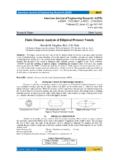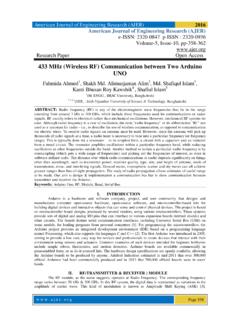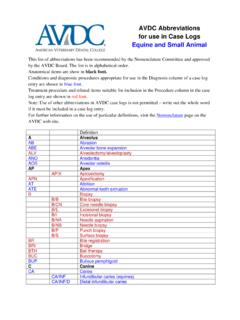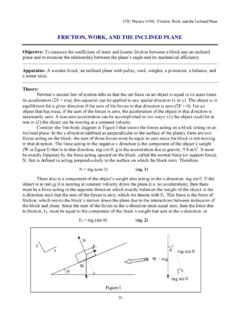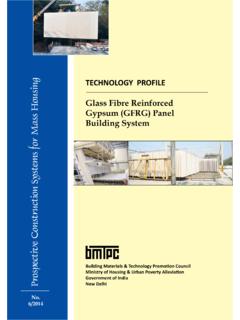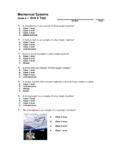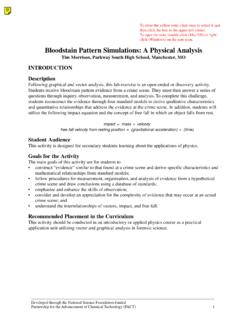Transcription of Shear Reinforcements in the Reinforced Concrete Beams
1 American Journal of Engineering Research (AJER) 2013 ww w . a j e r .o r g Page 191 American Journal of Engineering Research (AJER) e-ISSN : 2320-0847 p-ISSN : 2320-0936 Volume-02, Issue-10, pp-191-199 Research Paper Open Access Shear Reinforcements in the Reinforced Concrete Beams Moayyad M. Al-Nasra1, Naiem M Asha2 1(Department of Engineering Technology, West Virginia University Institute of Technology, Montgomery, West Virginia 25136, USA) 2(Department of Civil Engineering, University of Jordan, Amman Jordan) Abstract: - This study focuses on the use of different types of Shear reinforcement in the Reinforced Concrete Beams . Four different types of Shear reinforcement are investigated; traditional stirrups, welded swimmer bars, bolted swimmer bars, and u-link bolted swimmer bars.
2 Beam Shear strength as well as beam deflection are the main two factors considered in this study. Shear failure in Reinforced Concrete Beams is one of the most undesirable modes of failure due to its rapid progression. This sudden type of failure made it necessary to explore more effective ways to design these Beams for Shear . The Reinforced Concrete Beams show different behavior at the failure stage in Shear compare to the bending, which is considered to be unsafe mode of failure. The diagonal cracks that develop due to excess Shear forces are considerably wider than the flexural cracks. The cost and safety of Shear reinforcement in Reinforced Concrete Beams led to the study of other alternatives. Swimmer bar system is a new type of Shear reinforcement . It is a small inclined bars, with its both ends bent horizontally for a short distance and welded or bolted to both top and bottom flexural steel reinforcement .
3 Regardless of the number of swimmer bars used in each inclined plane, the swimmer bars form plane-crack interceptor system instead of bar-crack interceptor system when stirrups are used. Several Reinforced Concrete Beams were carefully prepared and tested in the lab. The results of these tests will be presented and discussed. The deflection of each beam is also measured at incrementally increased applied load. Keywords: Concrete cracks, Deflection, Shear , Stirrups, Swimmer bars I. INTRODUCTION One of the main objectives of the design of Reinforced Concrete Beams is safety. Sudden failure due to Shear low strength is not desirable mode of failure. The Reinforced Concrete Beams are designed primarily for flexural strength and Shear strength. Beams are structural members used to carry loads primarily by internal moments and shears.
4 In the design of a Reinforced Concrete member, flexure is usually considered first, leading to the size of the section and the arrangement of reinforcement to provide the necessary resistance for moments. For safety reasons, limits are placed on the amounts of flexural reinforcement to ensure ductile type of failure. Beams are then designed for Shear . Since Shear failure is frequently sudden with little or no advanced warning, the design for Shear must ensure that the Shear strength for every member in the structure exceeds the flexural strength. The Shear failure mechanism varies depending upon the cross-sectional dimensions, the geometry, the types of loading, and the properties of the member. Reinforced Concrete Beams must have an adequate safety margin against bending and Shear forces, so that it will perform effectively during its service life.
5 At the ultimate limit state, the combined effects of bending and Shear may exceed the resistance capacity of the beam causing tensile cracks. The Shear failure is difficult to predict accurately despite extensive experimental research. Retrofitting of Reinforced Concrete Beams with multiple Shear cracks is not considered an option [1]. Diagonal cracks are the main mode of Shear failure in Reinforced Concrete Beams located near the supports and caused by excess applied Shear forces. Beams fail immediately upon formation of critical cracks in the high- Shear region near the beam supports. Whenever the value of actual Shear stress exceeds the permissible Shear stress of the Concrete used, the Shear reinforcement must be provided. The purpose of Shear reinforcement is to prevent failure in Shear , and to increase beam ductility and subsequently the likelihood of sudden failure will be reduced.
6 American Journal of Engineering Research (AJER) 2013 ww w . a j e r .o r g Page 192 Normally, the inclined Shear cracks start at the middle height of the beam near support at approximately 450 and extend toward the compression zone. Any form of effectively anchored reinforcement that intersects these diagonal cracks will be able to resist the Shear forces to a certain extent. In practice, Shear reinforcement is provided in three forms; stirrups, inclined bent-up bars and combination system of stirrups and bent-up bars. In Reinforced Concrete building construction, stirrups are most commonly used as Shear reinforcement , for their simplicity in fabrication and installation. Stirrups are spaced closely at the high Shear region. Congestion near the support of the Reinforced Concrete Beams due to the presence of the closely spaced stirrups increase the cost and time required for installation.
7 Bent up bars are also used along with stirrups in the past to carry some of the applied Shear forces. In case where all the tensile reinforcement is not needed to resist bending moment, some of the tensile bars where bent-up in the region of high Shear to form the inclined legs of Shear reinforcement . The use of bent-up bars is not preferred nowadays. Due to difficulties in construction, bent-up bars are rarely used. In Beams with small number of bars provided, the bent-up bar system is not suitable due to insufficient amount of straight bars left to be extended to the support as required by the code of practice. In this study, three Reinforced Concrete Beams were tested using the new Shear reinforcement swimmer bar system and the traditional stirrups system. Several shapes of swimmer bars are used to study the effect of swimmer bar configuration on the Shear load carrying capacity of the Beams .
8 Only three Beams will be presented in this study. The first beam, BC, is used as a reference control beam where stirrups are used as Shear reinforcement . The other two Beams were Reinforced by swimmer bars. Beam, BW is the beam which is Reinforced by two swimmer bars welded to the longitudinal top and bottom bars. Beam, BU is the beam which is Reinforced by U-link bars which are bolted to the top and bottom longitudinal bars along with two swimmer bars. Extra stirrups were used to make sure that beam will fail by Shear in the swimmer bars side. In this investigation, all of the Beams are supposed to fail solely in Shear , so adequate amount of tension reinforcement were provided to give sufficient bending moment strength. This study aims at investigating a new approach of design of Shear reinforcement through the use of swimmer bars provided in the high Shear region.
9 The main advantages of this type of Shear reinforcement system are: flexibility, simplicity, efficiency, and speed of construction. Piyamahant (2002) showed that the existing Reinforced Concrete structures should have stirrup reinforcement equal to the minimum requirement specified the code. The theoretical analysis shows that the amount of stirrup of is appropriate. The paper concluded that small amount of web reinforcement is sufficient to improve the Shear carrying capacity. The study focused on the applicability of the superposition method that used in predicting Shear carrying capacity of Reinforced Concrete beam with a small amount of web reinforcement at the Shear span ratio of 3. Also the failure mechanisms were considered when small amount of stirrup used [2]. Sneed, and Julio (2008) discussed the results of experimental research performed to test the hypothesis that the effective depth does not influence the Shear strength of Reinforced Concrete flexural members that do not contain web reinforcement .
10 The results of eight simply supported Reinforced Concrete beam tests without Shear and skin reinforcement were investigated. The Beams were designed such that the effective depth is the variable while the values of other traditionally-considered parameters proven to influence the Shear strength (such as the compressive strength of Concrete , longitudinal reinforcement ratio, Shear span-to-depth ratio, and maximum aggregate size) were held constant. The values selected for the parameters held constant were chosen in an attempt to minimize the Concrete Shear strength [3]. Noor (2005) presented several results of experimental investigation on six Reinforced Concrete Beams in which their structural behavior in Shear was studied. The research conducted was about the use of additional horizontal and independent bent- up bars to increase the beam resistance against Shear forces.
